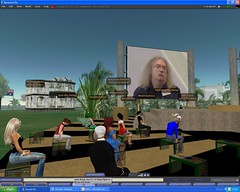| Stephen Downes (Photo credit: WordShore) |
I also think part of the problem comes from the age-old issue of looking at new technologies through the lens of the old - the "horseless carriage" problem (a car is not "horseless" because it never needed one). I think an example of this is found in the essay "A New Era of Unfounded Hyperbole" by Siva Vaidhayanathan, which gives us an example of a typical misunderstanding MOOCs:
"MOOCs, on the other hand, are more like fancy textbooks. They are all about the mass market and not the rich connectivity that established online courses offer their limited collection of students."This is a gross generalization of MOOCs. I would go so far as to call the statement above "unfounded hyperbole." The first MOOC I participated in "Connectivism and Connective Knowledge 2008" was one of the most interactive and engaging experiences in my education. There were a couple thousand participants who all self-organized into study groups and communities. This happened not on accident, but through the example and facilitation of the MOOCs teachers, George Siemens and Stephen Downes. They would not like the work "teacher" I think because it represents the traditional, hierarchical structure of traditional classes. I have never taken a class that was "all about the mass market." The reason why we wanted a class with a lot of people is because we learn in those networks - we get to take advantage of the the collective knowledge and talents of thousands of people. If your MOOC doesn't do that, you might not be in a "class."
When Vaidhayanathan is writing about MOOCs, I assume he is not writing about the MOOCs that came from David Wiley, George Siemens, Stephen Downes, Cormier, or Jim Groom. I am sure he is writing about Coursera and Edx. I would not make any generalizations about those because I have never taken a class in Coursera or Edx. What I will say is that their pedagogy and methods are different from what are sometimes called "cMOOCs" or "Connectivist MOOCs."
Another of Vaidhayanathan's generalizations says that
"The classroom has rich value in itself. It’s a safe, almost sacred space where students can try on ideas for size in real time, gently criticize others, challenge authority, and drive conversations in new directions."They can also be stultifying places where new ideas are not encouraged, where there is no real criticism, challenges to authority are not rewarded, and discussion discouraged (often because the lecturer won't/can't allow for the time). There are good face-to-face classes and bad. There are good online classes and bad. The same goes with MOOCs: my experience in CCK08 rivals my best classes at Berkeley or Sonoma State (both of which had some amazing classes).
Vaidhayanathan is not alone. I keep reading about the possibility of MOOCs going international when Canada has been in for four or five years ahead of the Ivy Leaguers. There are also a number of stories about how we might be able to take MOOCs for credit when this has been the case at University of Manitoba and Athabasca for years.
I do appreciate the last part of his article where he lists some possible upsides to MOOCs and asks that we "...focus on what we can learn and accomplish from the MOOC experiment and leave behind the unfounded hyperbole."
I would like to see less hyperbole and generalizations on both sides and more research.


I have so been thinking this since the 1st x peeked over the horizon. Since then I have and see both problems and possibilities. Left insufficiently supported, participants figure out connectivity for themselves and on their own. That is encouraging. There are other, less encouraging currents. Overall, x and c need to communicate and connect more.
ReplyDeleteOnly MOOOC is cMOOC by George and Stephen . Rest is I say NEW ONLINE = NOL
ReplyDeleteONLINE is around for 20 years . Most famous is University of Phoenix.+ 1300 other colleges at $ 1,500 per course. Therefore all small clases of 30 to 100 students.
NOL is not too much different than those onlines .
The differences of NOL are
1.- Delivered by the best schools of the world
2.- No fee for course but a small fee for exams
3.- No credit but certificate
Therefore they attracted many people as initial registration . Then 90 % stopped taking it .
Most important aspect here is ONLINE by BEST SCHOOLS. Therefore they attracted people, plus when there is no fee everybody just went into it . But stopped after assignments started .
Problem in USA today is college education for 18-22 years olds .
Colleges are expensive, quality is not sufficient.
They want best schools at least cost. That is EDX and Coursera. Sure non-profit EDX is better . But Coursera made the subject FAMOUS . Thanks to them too .
Now NOLs are for credit and degrees too. see my blog
www.savecolleges.blogspot.com
www.mitharvard.blogspot.com
how to get credits toward a degree by NOLs.